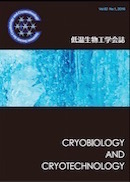Volume 51, Issue 1
Displaying 1-20 of 20 articles from this issue
- |<
- <
- 1
- >
- >|
-
Article type: Cover
2005Volume 51Issue 1 Pages Cover1-
Published: August 30, 2005
Released on J-STAGE: June 19, 2017
Download PDF (573K) -
Article type: Appendix
2005Volume 51Issue 1 Pages App1-
Published: August 30, 2005
Released on J-STAGE: June 19, 2017
Download PDF (26K) -
Article type: Index
2005Volume 51Issue 1 Pages i-
Published: August 30, 2005
Released on J-STAGE: June 19, 2017
Download PDF (42K) -
Article type: Index
2005Volume 51Issue 1 Pages ii-
Published: August 30, 2005
Released on J-STAGE: June 19, 2017
Download PDF (32K) -
Article type: Appendix
2005Volume 51Issue 1 Pages iii-
Published: August 30, 2005
Released on J-STAGE: June 19, 2017
Download PDF (25K) -
Article type: Appendix
2005Volume 51Issue 1 Pages iii-
Published: August 30, 2005
Released on J-STAGE: June 19, 2017
Download PDF (25K) -
Article type: Article
2005Volume 51Issue 1 Pages 1-11
Published: August 30, 2005
Released on J-STAGE: June 19, 2017
Download PDF (1246K) -
Article type: Article
2005Volume 51Issue 1 Pages 13-17
Published: August 30, 2005
Released on J-STAGE: June 19, 2017
Download PDF (447K) -
Article type: Article
2005Volume 51Issue 1 Pages 19-24
Published: August 30, 2005
Released on J-STAGE: June 19, 2017
Download PDF (640K) -
Article type: Article
2005Volume 51Issue 1 Pages 25-30
Published: August 30, 2005
Released on J-STAGE: June 19, 2017
Download PDF (685K) -
Article type: Article
2005Volume 51Issue 1 Pages 31-35
Published: August 30, 2005
Released on J-STAGE: June 19, 2017
Download PDF (519K) -
Article type: Article
2005Volume 51Issue 1 Pages 37-41
Published: August 30, 2005
Released on J-STAGE: June 19, 2017
Download PDF (524K) -
Article type: Article
2005Volume 51Issue 1 Pages 43-49
Published: August 30, 2005
Released on J-STAGE: June 19, 2017
Download PDF (718K) -
Article type: Article
2005Volume 51Issue 1 Pages 51-56
Published: August 30, 2005
Released on J-STAGE: June 19, 2017
Download PDF (599K) -
Article type: Appendix
2005Volume 51Issue 1 Pages 59-61
Published: August 30, 2005
Released on J-STAGE: June 19, 2017
Download PDF (150K) -
Article type: Appendix
2005Volume 51Issue 1 Pages 62-64
Published: August 30, 2005
Released on J-STAGE: June 19, 2017
Download PDF (209K) -
Article type: Appendix
2005Volume 51Issue 1 Pages 64-
Published: August 30, 2005
Released on J-STAGE: June 19, 2017
Download PDF (65K) -
Article type: Appendix
2005Volume 51Issue 1 Pages 65-
Published: August 30, 2005
Released on J-STAGE: June 19, 2017
Download PDF (45K) -
Article type: Appendix
2005Volume 51Issue 1 Pages App2-
Published: August 30, 2005
Released on J-STAGE: June 19, 2017
Download PDF (48K) -
Article type: Appendix
2005Volume 51Issue 1 Pages App3-
Published: August 30, 2005
Released on J-STAGE: June 19, 2017
Download PDF (16K)
- |<
- <
- 1
- >
- >|
